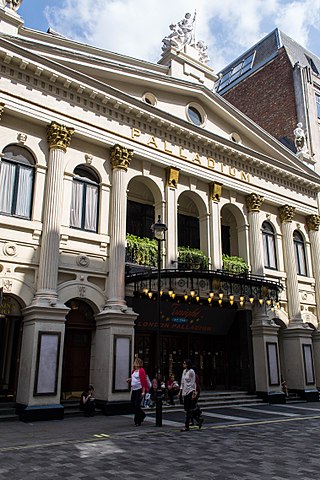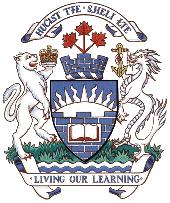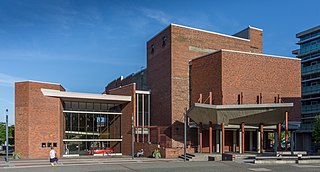
Victoria is the capital city of the Canadian province of British Columbia, on the southern tip of Vancouver Island off Canada's Pacific coast. The city has a population of 91,867, and the Greater Victoria area has a population of 397,237. The city of Victoria is the seventh most densely populated city in Canada with 4,406 inhabitants per square kilometre (11,410/sq mi).

The London Palladium is a Grade II* West End theatre located on Argyll Street, London, in Soho. The theatre was designed by Frank Matcham and opened in 1910. The auditorium holds 2,286 people. Hundreds of stars have played there, many with televised performances. Between 1955 and 1969 Sunday Night at the London Palladium was staged at the venue, produced for the ITV network. The show included a performance by the Beatles on 13 October 1963; one newspaper's headlines in the following days coined the term "Beatlemania" to describe the hysterical interest in the band.

Canada has a large domestic and foreign tourism industry. The second largest country in the world, Canada's wide geographical variety is a significant tourist attractor. Much of the country's tourism is centred in the following regions: Toronto, Montreal, Quebec City, Vancouver/Whistler, Niagara Falls, Vancouver Island, Canadian Rockies, British Columbia's Okanagan Valley, Churchill, Manitoba and the National Capital Region of Ottawa-Gatineau. The large cities are known for their culture, diversity, as well as the many national parks and historic sites.

New Westminster is a city in the Lower Mainland region of British Columbia, Canada, and a member municipality of the Metro Vancouver Regional District. It was founded by Major-General Richard Moody as the capital of the Colony of British Columbia in 1858 and continued in that role until the Mainland and Island colonies were merged in 1866. It was the British Columbia Mainland's largest city from that year until it was passed in population by Vancouver during the first decade of the 20th century.

Maple Ridge is a city in British Columbia, Canada. It is located in the northeastern section of Greater Vancouver between the Fraser River and the Golden Ears, which is a group of mountain summits which are the southernmost of the Garibaldi Ranges of the Coast Mountains. Maple Ridge's population in 2021 was 90,990. Its downtown core area was once known as Haney.

Royal Roads University is a public university with its main campus in Colwood, British Columbia, Canada. The university is located at Hatley Park National Historic Site on Vancouver Island and is the successor to the Royal Roads Military College (RRMC), which was originally a training base for naval officers and later Canadian Air Force and Army personnel. After the end of the Cold War, the college was decommissioned, however, it was reinstituted following negotiations between the Department of National Defence and the Government of British Columbia by which the Royal Roads University Act was passed, leading to the establishment of Royal Roads University in June 1995.

Montreal Forum is a historic building located facing Cabot Square in Montreal, Quebec, Canada. Called "the most storied building in hockey history" by Sporting News, it was an indoor arena which served as the home of the National Hockey League's Montreal Maroons from 1924 to 1938 and the Montreal Canadiens from 1926 to 1996. The Forum was built by the Canadian Arena Company in 159 days. Today most of the Forum building is now a multiplex cinema known as Cineplex Cinemas Forum operated by Cineplex Entertainment. Additionally, a large portion of the building's upper floors are used as campus expansion for Dawson College.

Greater Victoria is located in British Columbia, Canada, on the southern tip of Vancouver Island. It is usually defined as the thirteen municipalities of the Capital Regional District (CRD) on Vancouver Island as well as some adjacent areas and nearby islands.

The Edinburgh International Festival is an annual arts festival in Edinburgh, Scotland, spread over the final three weeks in August. Notable figures from the international world of music and the performing arts are invited to join the festival. Visual art exhibitions, talks and workshops are also hosted.

The Ed Mirvish Theatre is a historic performing arts theatre in Toronto, Ontario, located near Yonge–Dundas Square. Owned and operated by Mirvish Productions, the theatre has approximately 2,300 seats across two levels. There are two entrances to the theatre, located at 263 Yonge Street and 244 Victoria Street.

Dame Clara Ellen Butt was an English dramatic contralto and one of the most popular singers from the 1890s through to the 1920s. She had an exceptionally fine contralto voice and an agile singing technique, and impressed contemporary composers such as Saint-Saëns and Elgar; the latter composed his Sea Pictures, Op. 37 with her voice in mind.

Hosting the region's largest urban population, Halifax, Nova Scotia is an important cultural centre in Atlantic Canada. Halifax is home to a vibrant arts and culture community that enjoys considerable support and participation from the general population. As the largest community and the administrative centre of the Atlantic region since its founding in 1749, Halifax has long-standing tradition of being a cultural generator. While provincial arts and culture policies have tended to distribute investment and support of the arts throughout the province, sometimes to the detriment of more populous Halifax, cultural production in the region is increasingly being recognized for its economic benefits, as well as its purely cultural aspects.

Banshees Over Canada is a 19-minute 1943 Canadian documentary film, made by the National Film Board of Canada (NFB). The film was produced by Sydney Newman and directed by James Beveridge. The film's Canadian French title was Vautours au-dessus du Canada. It was produced as part of the wartime Canada Carries On series.

Victoria Theatre in Halifax, West Yorkshire, England, is a large theatre and concert hall that opened in 1901.

Victoria Harbour is a harbour, seaport, and seaplane airport in the Canadian city of Victoria, British Columbia. It serves as a cruise ship and ferry destination for tourists and visitors to the city and Vancouver Island. It is both a port of entry and an airport of entry for general aviation. Historically it was a shipbuilding and commercial fishing centre. While the Inner Harbour is fully within the City of Victoria, separating the city's downtown on its east side from the Victoria West neighbourhood, the Upper Harbour serves as the boundary between the City of Victoria and the district municipality of Esquimalt. The inner reaches are also bordered by the district of Saanich and the town of View Royal. Victoria is a federal "public harbour" as defined by Transport Canada. Several port facilities in the harbour are overseen and developed by the Greater Victoria Harbour Authority, however the harbour master's position is with Transport Canada.
Royal Jubilee Hospital is a 500-bed general hospital in Victoria, British Columbia, Canada located about 3 km (1.9 mi) east of the city centre, in the Jubilee neighbourhood.
Pacific Opera Victoria is a professional Canadian opera company in Victoria, British Columbia. It designs, builds, and stages original opera productions at the Royal Theatre with the Victoria Symphony. The company also presents smaller scale works and community programming at the Baumann Centre.

City Opera of Vancouver is a professional chamber opera company in Vancouver, Canada, founded in 2006. Its past productions include the Vancouver premiere of Nigredo Hotel by Ann-Marie MacDonald and Nic Gotham; commission and premiere of 'Missing', by librettist Marie Clements and composer Brian Current, given in co-production with Pacific Opera Victoria; the premiere of a 'new' Mozart chamber opera, 'The Lost Operas of Mozart'; the world premiere of Pauline, a chamber opera with an original libretto by Margaret Atwood; the commission and workshop premiere of 'Fallujah', with music by Tobin Stokes and libretto by Heather Raffo, and supported by the Annenberg Foundation of Los Angeles; the Canadian event premiere of Sumidagawa and Curlew River in double bill; and, the British Columbia premiere of Viktor Ullmann's The Emperor of Atlantis.

The McPherson Playhouse, known as The Mac, is a theatre and concert hall in Victoria, British Columbia, Canada. Part of the Centennial Square complex on the north side of downtown Victoria, adjacent to the intersection of Pandora and Government streets across from the CTV Vancouver Island studios and the Victoria City Hall, it was originally built as a Pantages Theatre in 1914. In the 1960s it was donated, with supporting funding for its renovation, to the people of Victoria by Thomas Shanks McPherson. It became part of the Centennial Square redevelopment, finished in 1965. Renovations preserved and refurbished the Neo-Baroque auditorium but added a modern lobby and various technical improvements.

















